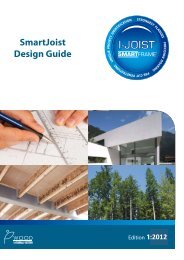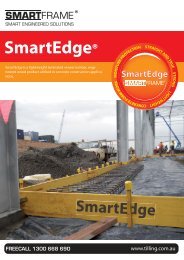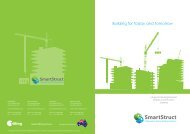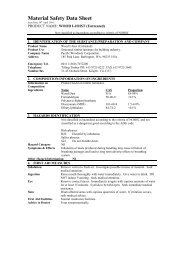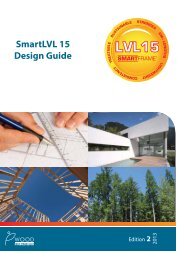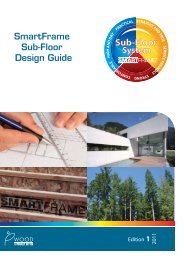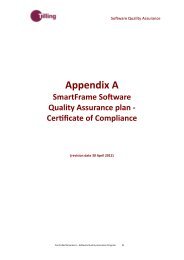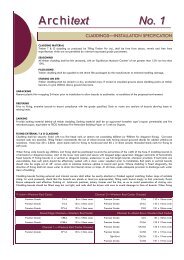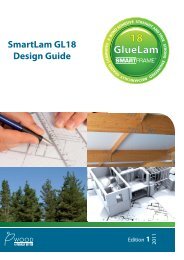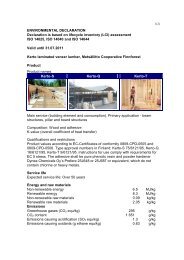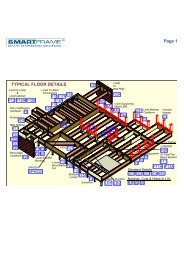SmartJoist Design Guide 2011.pub - Tilling Timber
SmartJoist Design Guide 2011.pub - Tilling Timber
SmartJoist Design Guide 2011.pub - Tilling Timber
Create successful ePaper yourself
Turn your PDF publications into a flip-book with our unique Google optimized e-Paper software.
SmartGuard TREATMENT<br />
The treatment of timber to extend its service life is covered<br />
by AS/NZS 1604. This code identifies the various biological<br />
hazards by a hazard class number, with hazard class numbers<br />
from H1 - H6. The higher the hazard class number,<br />
the greater the severity of the biological hazard. A complete<br />
table listing the 6 hazard classes is contained within AS/<br />
NZS 1604.1.<br />
All <strong>SmartJoist</strong>s can be supplied SmartGuard treated to<br />
either H2s as per the table below, or alternatively may be<br />
after-market LOSP H2 treated by an experienced and approved<br />
timber preserver.<br />
Water borne treatments are NOT suitable for <strong>SmartJoist</strong>s.<br />
It is also NOT recommended that <strong>SmartJoist</strong>s be specified<br />
for use outside above ground, even if H3 treated. This is<br />
predominately due to the geometric shape of the I-Joist<br />
which will not shed water effectively.<br />
Further information on SmartGuard treated I-Joists can be<br />
obtained on 1300 668 690 or at smardata@tilling.com.au<br />
* All <strong>SmartJoist</strong>s are manufactured from materials not<br />
susceptible to Lyctid attack<br />
Hazard Class Exposure Specific service conditions Biological hazard Typical uses<br />
H1*<br />
inside, above<br />
ground<br />
Completely protected from the weather and<br />
well ventilated, and protected from termites<br />
Lyctid borers<br />
Interior beams, stair cases,<br />
stringers<br />
H2s<br />
inside, above<br />
ground<br />
South of the Tropic of Capricorn ONLY<br />
Protected from weather, Nil leaching<br />
Borers and termites<br />
Interior joists, rafters and roof<br />
beams<br />
H2<br />
inside, above<br />
ground<br />
Protected from weather, Nil leaching<br />
Borers and termites<br />
Interior joists, rafters and roof<br />
beams<br />
ADHESIVE AND FORMALDEHYDE EMISSION FACTS<br />
Q. Are the glues used in SmartFrame Engineered Wood<br />
Products safe?<br />
A. Yes, they are safe, Phenolic resins used in our<br />
Engineered Wood Products are stable, polymerised<br />
materials. The polymerisation reaction is non-reversible<br />
(i.e. once the polymer is formed, it doesn’t break down).<br />
A wood dust warning label is provided for all SmartFrame<br />
wood products to alert our customers that wood dust can<br />
be generated by sawing, sanding, or machining wood and<br />
wood products.<br />
Q. What is the level of formaldehyde emission from our<br />
phenolic-bonded Engineered Wood Products?<br />
A. Independent third party testing has confirmed that<br />
formaldehyde emissions from our phenolic-bonded products<br />
(i.e.. OSB, LVL, I-Joists, and Glulam) are below 0.5<br />
mg/L under reasonably foreseeable conditions of use,<br />
which meets or exceeds the E 0 Formaldehyde Emission<br />
Class<br />
In short, all available information indicates that<br />
formaldehyde levels associated with phenolic resin-bonded<br />
wood products are similar to those of the dimension<br />
lumber veneer or other forms of wood used to make the<br />
products.<br />
Q. How much formaldehyde is in our phenolic-bonded,<br />
Engineered Wood Products?<br />
A. The amount of formaldehyde in our Engineered Wood<br />
Products is less than 0.1 percent of the dry weight.<br />
Q. What is being done to reduce the exposure to formaldehyde?<br />
A. Formaldehyde is normally present at low levels, usually<br />
lower than 0.03 ppm, in both outdoor and indoor air.<br />
Efforts have been made by both government and industry<br />
to reduce exposure to formaldehyde. A 1985 regulation<br />
by the US Department of Housing and Urban<br />
Development (HUD), covering the use of manufactured<br />
pressed wood products in housing was designed to ensure<br />
that indoor levels were below 0.4 ppm. Product<br />
standards established for plywood and particleboard led to<br />
significant reductions in formaldehyde emissions from<br />
those products. Furthermore, HUD acknowledged that<br />
phenolic resin bonded wood products emitted such small<br />
quantities of formaldehyde that these products were<br />
exempted from all the testing and certification<br />
requirements of the standards. In Germany, the German<br />
Hazardous Materials regulation, better known as the “E1”<br />
Standard, sets a limit of 1.0 mg/L for formaldehyde<br />
emissions from some wood-based composite products.<br />
All available data indicates that our phenolic bonded<br />
Engineered Wood Products meet the more stringent E 0<br />
level.<br />
Q. What affects formaldehyde levels in a home?<br />
A. Formaldehyde levels in the indoor air depend mainly on<br />
what is releasing the formaldehyde, the temperature, the<br />
humidity, and the air exchange rate (i.e. the amount of<br />
outdoor air entering or leaving the indoor area) Levels of<br />
formaldehyde decrease with increasing air exchange rate,<br />
decreasing temperature, and decreasing humidity.<br />
<strong>SmartJoist</strong> <strong>Design</strong> <strong>Guide</strong> 37



